This article may contain affiliate / compensated links. For full information, please see our disclaimer here.

When my partner Tom and I first started our travel blog Adventure In You, the only people who read it were our parents, grandparents and one of my classmates from middle school.
We were publishing tons of articles every single day, posting often on social media, and doing everything we (thought we) could to get people to read our blog…
But no matter what we did, we felt like we were drowning in a sea of other blogs.
Fast forward 5 years and now we have more than 500,000 people visiting our blog every single month.
That’s right – we went from a tiny handful of family and friends to half a million people reading what we’re publishing!

How exactly did we do this?
We realized that what we were doing wasn’t really working so we pivoted our focus, became smart and strategic about what we published and implemented different strategies to drive more readers to our blog.
We quickly realized that being strategic and working on the right things allowed us to use our time better. This meant we were able to complete tasks that would actually make an impact rather than just jumping from one thing to the next, hoping to see some results.
The thing is, if you have limited time to devote to your blog, you want to be sure you’re working on the right things to drive traffic because it’s something that’s very hard to come by naturally.
You want to be doing the work that really matters.
This means being smart about your actions and deliberate with your plan of attack so that the time you do have to work on your blog actually counts.
I guarantee that with these strategies and a solid system to implement them, you can get consistent traffic to your blog, even if you’re working full-time.
- How to Get People to Read Your Blog
- Traffic Tip #1: Know and Understand Your Audience
- Traffic Tip #2: Create Valuable Strategic Content
- Traffic Tip #3: Take the Time to Learn SEO
- Traffic Tip #4: Use Email Marketing to Drive Traffic
- Traffic Tip #5: Don’t Fall Into the Social Media Trap
- What’s Next for My Blog?
How to Get People to Read Your Blog
The million dollar question for any blogger is, how exactly can you get people to read your blog?
You’re writing articles, publishing them online, sharing them all over social media but still not seeing a lot of traffic…
If this sounds like you, know that you’re not alone.
We were in the exact same boat a couple of years ago. In fact, for the first year of running our travel blog, we could barely get anyone to our site.
But after lots of trial and error, plus lot’s of talking to other bloggers who were succeeding in the traffic department, we began to pivot our strategy.
Instead of writing hundreds of articles about whatever we felt like, we started creating content based on what our target audience actually wanted to read about.
We deep dived into implementing SEO strategies as we created articles that were focused on our readers to boost our search engine rankings. We also used email marketing more effectively to get people back to our blog over and over.
This made all the difference.
Finally, after lots of trial and error, a whole lot of patience, and faith in ourselves, we started seeing results.
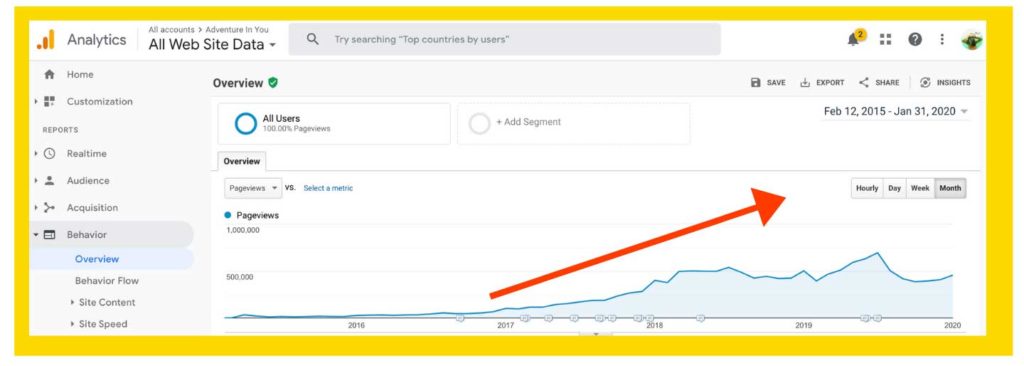
Our traffic increased tremendously and we started seeing more and more people roll in every day. This is because we made strategic and systematic changes to our blogging approach.
Remember, if you’re strategic with what you do, you can absolutely implement these tips on your blog while you’re still working your full-time job. So without further ado, here are a few of my top traffic tips to drive people to your blog.
Traffic Tip #1: Know and Understand Your Audience
One of the biggest keys to getting more readers to your blog is to know and understand your audience. Keep creating valuable content and they’ll keep on coming back for more!
To do this, you need to do two things:
- Get super specific with your blogging niche
- Determine your ideal reader
Structuring your blog around these two factors will allow you to stand out in the sea of more than 500 million blogs online!
If you can stand out, this means you’ll be able to continuously capture traffic from your target audience.

Get Super Specific About Your Niche
If you’ve been mulling over the idea of starting a blog for some time, chances are you already have an idea of what you want your blog to be about.
Or if you already have a blog, you might already have a niche.
Maybe you’re like us and your blog is about travel. Or perhaps it’s food, parenting, fitness, beauty…
Whatever your niche is, I’m now challenging you to get even more specific about your blog’s topic.
As I’ve mentioned above, there are over 500 million blogs out there today… and your best chance for success is to further niche down.
Take Adventure In You as an example.
When we started, adventure travel was our niche… and we thought we had niched down enough to find an audience and carve a space for ourselves.
But it was only when we niched even further down to focus on specific destinations and writing adventure reviews did we finally see some traction in growing our blog!
In our Blogging Fast Lane course, we teach our students how to pick their niche based on the idea of a Blue Ocean, a concept derived from a business strategy by W. Chan Kim and Renée Mauborgne.
Their strategy says that there are two types of oceans in any business: a Blue Ocean and a Red Ocean.
Red Oceans represent oversaturated markets, brimming with competition, making it a challenge for new people to enter. On the other side, there are Blue Oceans where newcomers are able to carve out a sub-niche that is so specific that it creates a new space in the market.
Here’s how creating a Blue Ocean applies to blogging:
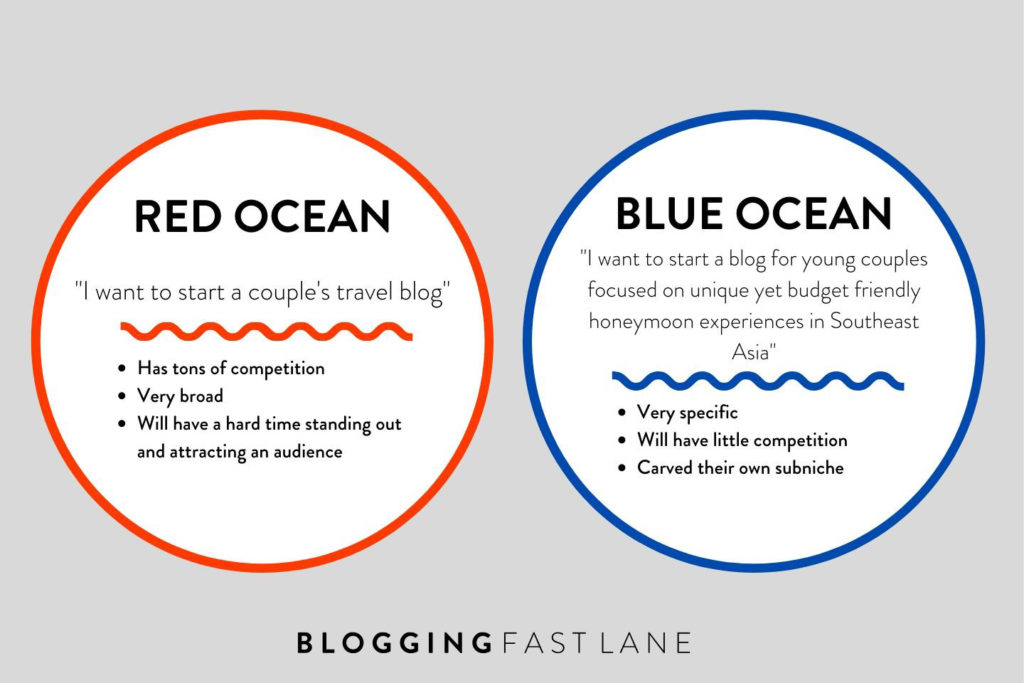
Finding your Blue Ocean should be a combination of:
- Your Passion (knitting, gardening, photography, fitness)
- Any Unique Skill / Life Experience (I created a workout plan, I am great at editing photos, I lived in a camper van for 6 weeks)
- Your Ideal Audience (this is your reader avatar, which I explain next)
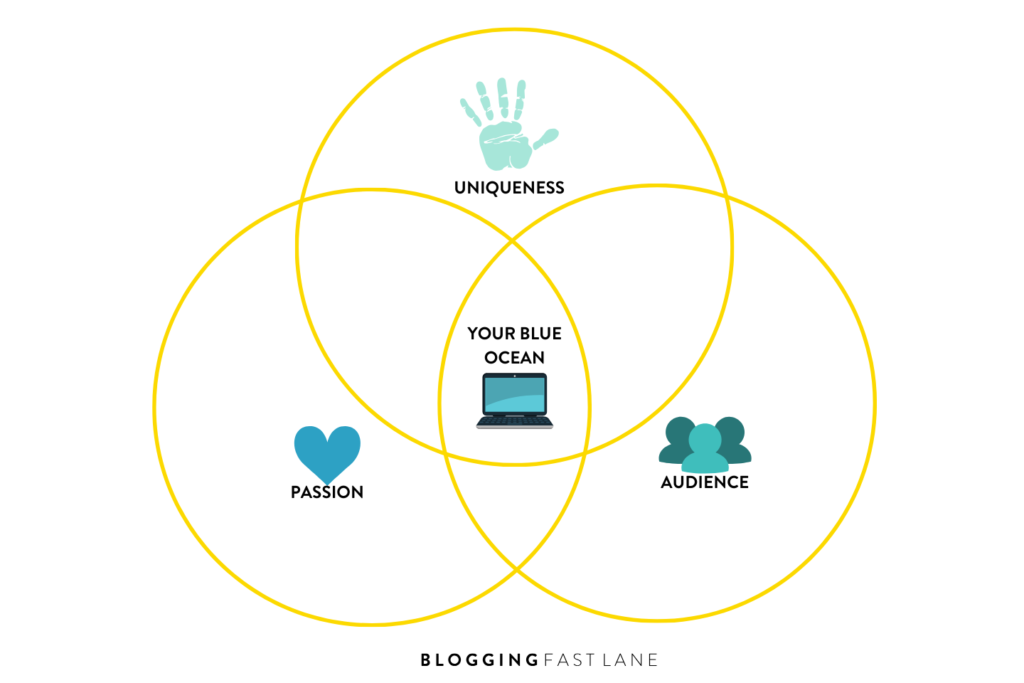
Now it’s time to brainstorm.
Grab a piece of paper and create three columns (one for each of the topics above). List as many items as you can in each column and then take a look.
Are there any intersections here? Can something fit together to make your blog unique and stand out?
Using this method allows you to actually appeal to an audience who’s looking for something specific, rather than trying to get everyone in the world to read your blog.
With a Blue Ocean, you can write content that you already know your readers are going to love, giving them a reason to keep on coming back and incentive to share your articles with their friends.
Read More: The Ultimate Guide to Finding a Profitable Blogging Niche
Determine Your Reader Avatar
You may be thinking, “Well, how do I know who my audience is? How do I figure out who I should be writing to?”
A great solution is to put together a reader avatar.
A reader avatar is a fictional personality that you get to create based on your ideal blog reader. This helps you imagine who you’re speaking to and craft content that will appeal to them.
Some components of a reader avatar you should think about are:
- Age: What age range do you want to attract/ appeal to?
- Gender: Is your blog targeting men or women? Are you writing from a unique women’s perspective? Promoting men’s products? Or does your content apply to everyone, regardless of gender?
- Budget: Are you targeting big spenders or people on a small budget? Are you writing about luxury or low-budget topics? Do they mind the occasional splurge?
- Hobbies: What does your ideal reader like to do for fun? What are their interests?
- Problems: What kind of problems do your readers have? What problems can you help solve for them?
- Online Behavior: Where does your target audience hang out online? When do they use the internet? What social media platform do they use? Do they surf the web on their phone or computer?
Once you define these qualities, write out a little story about them that you can refer to whenever you feel like you aren’t sure who you’re writing to.
It can be something like this:
“Meet Sarah. She’s 26 years old, works full-time but loves to travel when she gets time off. She doesn’t make too much money and what she does make, she puts away for flights or budget accommodation wherever she’s headed off to. When she’s not traveling, she likes to plan future trips, learn about different cultures, and try new foods.”
We did this exact same exercise when we first started envisioning our reader avatar for Adventure In You.
All of the information about your reader avatar will help you write articles that relate directly to your ideal reader, making your content so much more powerful.
It will also help you pick out the right products to recommend, relatable images, and so much more.
Think about it. If you know you’re writing for women in their late 30s-40s who are interested in luxury getaways, when making recommendations on where to stay or what to do in a city, you’ll know exactly what type of hotels and activities to feature in your articles.
The thing about blogging is you don’t need to be the best writer in the world to get people to read your content or visit your blog. You just need to write in a way where your ideal reader can relate to what you’re saying.
If you can do that, your readers will keep coming back to your blog as you are repeatedly providing them value or helping them solve a problem.
Traffic Tip #2: Create Valuable Strategic Content
Once you know who you’re targeting with your blog, it’s time to start creating content that they’ll find valuable.
To drive traffic to your blog, you’ll need to create content that solves your readers’ problems. If you provide value or solve your reader’s problem, they’re likely to be hooked and return for more.
Take the case of the blog for women keen on luxury travel. If you’ve given them great recommendations on where to stay in Paris, chances are, for their next holiday, they will come to your blog first as during their last trip, you were able to provide heaps of good recommendations tailored to them.
This directly translates to being strategic about what you write. The thing is, if you want your blog to truly succeed, blogging isn’t just about creating 100 articles about whatever you feel like.
Instead, you need to think strategically about how to provide value to your readers surrounding your Blue Ocean.
Check this out:
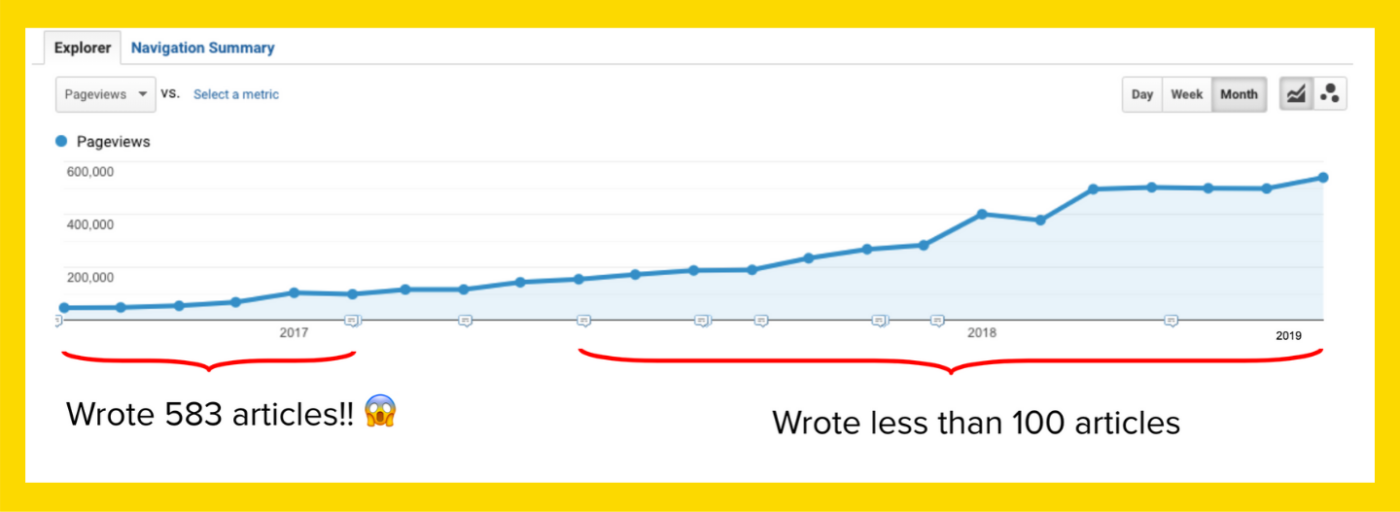
When we started to be strategic about the content we produced, our traffic tripled in less than a year!
See the graph above? We ended up wasting almost two years, writing content that no one ever read. As we got a lot more strategic, we produced LESS articles, and yet our traffic started to grow.
So how exactly did we do this?
Build Authority Pillars
First, we structured our content into Authority Pillars.
In our Blogging Fast Lane course, we teach our students how to build an Authority Fortress around their Blue Ocean. This creates a strong group of related content that is highly likely to perform really well on Google.
Why?
Having an Authority Fortress makes it easier for the search engine to see your content as highly relevant and authoritative.
Think about it. If you are trying to rank for a recipe for Pasta Carbonara…what will rank Google most likely give preference to?
A general food blog featuring 20 different recipes around Thai, Indian, and Itialian food or a blog with 20 traditional Italian food?
Content relevancy matters!
An Authority Fortress is then broken down into Authority Pillars, which contain loads of sub-articles around related topics.
It looks something like this:
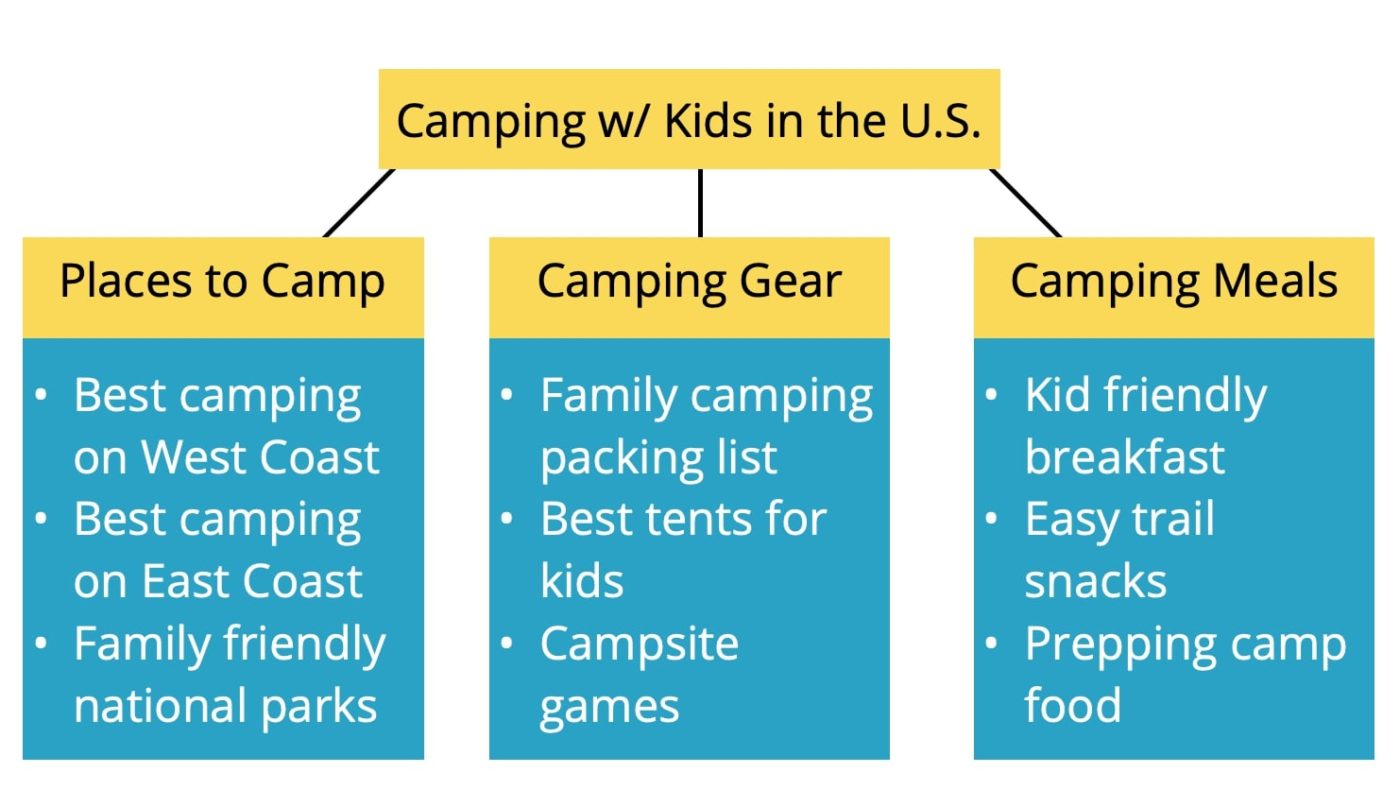
Say your Authority Fortress surrounds camping with kids in the U.S.
You can have an Authority Pillar around something like “best places to camp with kids”, and then write loads of articles about the top places to take children camping around the States!
After building out a solid first pillar, you can move on to things like “gear you need to camp with kids” and fill it out with articles like packing lists, product recommendations, and more.
By building out a quality Authority Fortress with strong pillars, you’re making your blog a one-stop-shop for anyone interested in your blog topic. At the same time, you’re also showing Google that you know what you’re talking about!
This results in higher search engine rankings, increased traffic and more people on your blog who care about what you’re writing about.
Want to learn more about how to build an Authority Fortress on your blog?
We walk you through this exact concept in more detail in our free training!
Make Sure to Do Keyword Research
So how exactly do you figure out what type of content your readers want?
Enter: keyword research.
Keyword research is one of the most powerful tools when it comes to creating high-quality content that attracts the tribe you’re hoping to target.
Essentially, keyword research is the process of finding out what people are searching for on search engines using specific words.
There are a few awesome online tools for doing keyword research like Keysearch, which is pretty user-friendly and home to an unbelievable amount of data.
Keysearch is a super affordable tool that has both yearly AND monthly plans. If you would like to try the tool, use the coupon code “FASTLANE” for a discount!
With a keyword research tool, not only can you find different keywords in your niche, but you can also figure out how many people are searching for what, how difficult it is to compete with a keyword and related phrases, as well.
Keyword research is valuable for a couple of reasons:
- It helps you create content people actually want to read. If you’re doing keyword research and see that there are a lot of people searching for “how to start a home garden” and your blog is about growing fresh veggies in your backyard, utilizing these keywords will help get your content in front of people who are looking for it.
- Keyword research is invaluable for SEO. If you’re looking for how to increase traffic to your blog, using keywords in your article is one of the top ways to start ranking on search engines. If you use the keywords “how to start a home garden” several times (naturally), when Google analyzes your article it’ll be able to tell that what your article is all about. Remember, Google is only an algorithm and it needs context cues like keywords to be able to figure out what the topic is.
If you go about creating content willy-nilly, you’ll have a lot of stuff on your blog, but it may not be of much value to your ideal reader.
Keyword research is a way to ensure that you’re writing articles that people are actually searching for, increasing the chances they’ll come back for more.
Read our Keysearch review and tutorial to learn exactly why a keyword research tool is so valuable.

Traffic Tip #3: Take the Time to Learn SEO
When it comes to boosting your rankings and getting people to read your blog, there are few factors more powerful than SEO or Search Engine Optimization.
Search Engine Optimization (SEO) is the process of making your website more visible to search engines, resulting in increased traffic. In short, SEO is what gets a webpage to the top of search results.
And if you’re at the top of search results, of course way more people are going to visit your blog than if you’re article is hidden on the 20th page of Google.
SEO is crucial for getting people to read your blog and it’s the key to building organic traffic.
When you’re first starting out with a blog, the idea of SEO can be so intimidating!
With all that’s going on, it may seem like a far-flung dream to tack on learning another skill when you’re trying to get your blog up and running in the first place.
…But if you do take the time to learn the basics and implement them on your blog, you’ll see that it’s not all that hard and makes a world of difference when it comes to traffic.
Implementing SEO is essential because Google gets more than 2.5 trillion searches per year. This means that there are more than 80,731 searches per second!
When you can get the search engine to work in your favor via SEO, you’re setting your blog up to be in front of way more eyes than it would be otherwise.
So how do you actually do this?
SEO can be broken down into 2 main components: on-site SEO and off-site SEO.
Both should be worked on in order to improve your blog’s SEO, but I recommend beginning with optimizing your on-site SEO first.
On-Site SEO
There are certain things that you can actually do on your blog that improves SEO and leads to better rankings.
The biggest piece is optimizing the content in your blog.
Some important factors of on-site SEO are:
- Using your keyword research: After you compile a list of keywords you want to rank for, you actually need to include them in your article.
- Headings: Using appropriate headings is a great way to let Google know what your article is about. Think of headings as your article outline. By saying which points are most important and which ones are subpoints, you’re providing even more context cues for Google. You should try and include keywords in your H1 tags, SEO title, and any other headings you use in your content.
- URL Structure: Your article URLs should be short, to the point, and easy to read. Get rid of unnecessary stop words (like, and, is, etc…) and try to fit a keyword in there! When you have a keyword in your URL, you’ll have a 45% greater click-through rate than if you didn’t include it at all! Your URL should be directly related to your title but much more condensed.
ex:
Incorrect: www.yourblog.com/my-moms-best-apple-pie-recipe-ever
Correct: www.yourblog.com/best-apple-pie-recipe
- Load Time: Make sure that your blog actually loads quickly! The most common culprit of slow load times on blogs are super big images. To fix this, there are tons of websites that allow you to compress images, making them a more manageable size. Not only does this help with your SEO, but helps retain readers, too. I mean, who wants to stay on a blog that doesn’t load?
While this is just the tip of the iceberg, doing these simple things really allows Google to easily understand what your blog is about, identify if it’s relevant to a search keyword, and (hopefully) place you in a higher ranking position.
In our full course, we have an ENTIRE module dedicated to SEO as we know it is key to get continuous traffic from search engines.

Off-Site SEO
Besides optimizing your own website, there are other things you can do outside of your blog to boost SEO and search engine rankings as well.
One of the biggest contributing factors to off-site SEO is backlinks!
This is when another website or blog links to one of your articles. With enough backlinks, this shows Google that your article must be one of the best out there since so many people are linking out to it!
Backlinks are the best way to build authority which ultimately leads to better rankings and more traffic.
Here are 3 ways to link build to your blog.
1. Guest Posts
A great method of getting backlinks (especially as a beginner blogger) is by writing guest posts. This is where you write an article and publish it on someone else’s blog. Although this sounds counter-intuitive to write articles for someone else, it is a GREAT way of getting backlinks.
Guest posts can:
- Get you a backlink from a high authority website. If you write a guest post for a well-established blog, they will get some link juice flowing your way. Just remember, the higher a website’s domain authority, the stronger their link juice.
- Build your credibility as an expert. By posting about a topic on someone else’s blog, you’re showing that you know enough about it that other people are seeking your expertise! This not only builds authority in Google’s eyes, but in readers as well. If someone comes across your guest post and feels like you really know what you’re talking about, what’s stopping them from becoming a loyal reader of your blog?
- Lead to referral traffic. With guest posts, you’ll get a link out to your blog and no matter how authoritative the website is, you can still count on it sending some readers your way. This increases traffic, boosts the likelihood of your blog getting shared, and has the potential to add to your engaged audience!
When it comes to writing guest posts, there are a few things you should keep in mind.
- Stick to your niche! In terms of SEO, it’s way more valuable to write for someone related to your niche, rather than post on a random website. If your blog is about backyard gardening, it’s getting a link from a tech blog doesn’t seem natural… You see what I mean?
- Choose non-competing keywords. Write guest posts about topics that you aren’t trying to rank for yourself. If you write using keywords you’re trying to compete for, you’re effectively moving the link juice from your blog to whoever you’re guest posting for.
- Give your best work. When writing guestposts for others, it is important to put your best foot forward! Although it is tempting to save your best articles for your own blog- you want to make sure that the guest post that you provide is super high quality! By doing this, you are also increasing your chances of receiving referral traffic to your blog which can translate to loyal readers.
Some bloggers are always open to guest posts, so if there’s someone you admire or want to write for, drop them a message and ask what their policy is. We recommend building a relationship first rather than just emailing them for a favor.
For more on guide posting, check out our full guide here.
2. Press & Media Features
Another way to get backlinks is to reach out to press or media websites to see if they’ll run a feature on you and link out to your blog.
Typically, popular media websites have high domain authority, making their links much more powerful. Plus, they get a lot of traffic coming through and that traffic can be redirected to you if you’re featured!
This is one of the best ways to build authority because it shows that you really know what you’re talking about.
As a beginner (or even intermediate) blogger, it’s unlikely you’re going to be featured on National Geographic, Good Housekeeping, or Cosmopolitan.
… BUT there’s a good chance you can get features from local online news sites.
When we were getting Adventure In You going, Tom persistently reached out to tons of local news outlets in his little hometown in the U.K.
While not everyone gave us the time of day, some websites were gracious enough to do a feature on us. After this, we then started finding unique angles about our story and started pitching larger media sites.
This resulted in news features from:
Getting links from well-established websites did wonders for our domain authority, which ultimately led to being more trustworthy in Google’s eyes. And since Google trusted us, we began to rank higher!
When your blog gets to a point where you have loads of content and it’s really built out, try sending emails to your local online newspaper or magazine.
Let them know that you’re from there and are starting a new venture. Don’t be afraid to share your story- not only could this result to a backlink but also to potential readers.
3. Collaboration Posts
One last way to link build is to participate in collaboration posts.
This is where you write a paragraph or two for a large joint post organized by another blogger. Everyone shares the writing responsibility and everyone gets a link to their individual blog at the end.
While it’s not as powerful for SEO (as the link juice in the collaboration will be distributed across all the linked blogs in the post), it’s a great way to get your blog out there and find lots of bloggers in your niche.
In all honesty, link building can be pretty time consuming but it’s totally worth it when it comes to SEO. Plus, you’ll probably make a few blogger friends along the way!
For a more in-depth guide to SEO for bloggers, check out this article.

Traffic Tip #4: Use Email Marketing to Drive Traffic
If there’s one thing I regret about our blogging journey, it’s that we didn’t get into email marketing sooner.
The moment you start your blog, you should begin to also start building your email list. This way, you can start to use emails to drive people back to your articles over and over again.
Not only will you drive traffic to your blog, but you’ll also be building loyal readers as you are able to continuously provide them with value.
With email marketing, you can target your ideal audience, build trust with them, and then deliver value through emails.
These emails act as a direct catalyst to your blog, bringing readers back over and over again.
Once we implemented email marketing and developed our strategy, we started to see an astounding spike in traffic and engagement on Adventure In You, showing that our audience really did care about what we had to say and would keep on coming back if we showed we could continue to provide value.
Here are the 2 two things to focus on to drive traffic back to your blog: grow your email list and build trust.

Grow Your Email List
Having an engaged email list goes such a long way when it comes to getting people to read your blog.
Your email list is essentially a direct connection to your audience, allowing you to reach out, find out the type of content they want, and drive them back to your blog. It also allows you to connect with your readers on a more personal level!
Your email list should be full of people who love your blog so much that they want to stay in the know. This means that you can talk to them on a more intimate level than you can on your blog.

As you continue to grow your audience, you can put your content right in front of them with your emails, even if they aren’t visiting your blog on a regular basis. An email will show up in their inbox that directly relates to them; this piques their interest and sends them back to your blog to read your content.
Remember- targeted email lists are always better than generic ones!
Want to learn how to grow your email list? Read this article for our top tips.
Build Trust
So how can you grow an engaged email list? Our secret is to focus on building trust with your readers.
If you’re anything like me (and most people who read blogs), a “Subscribe” button has very little influence. It’s no secret that people are quick to close pop-up boxes if they think they’re going to get more spam in their inbox.
We saw this happen in real life!
When we started thinking about growing our email list for Adventure In You, we put out a generic “sign up for our list to get updates” button and saw very few results.
After a couple of years of letting our email list fall by the wayside, we realized the importance of building trust in this process and stepped up our game.
One of the top ways we build trust with our readers is by offering a value gift.
This worked so well that today our email list has more than 95,000+ subscribers and it’s central to our strategy and blog in general.

Why does this work?
By giving your readers something that they’ll view as valuable, they’ll recognize that you’re trying to deliver something they’re interested in and be more likely to hand over their email in return for your value gift.
And when they join your list, you can really nurture the relationship through email automations, which allows you to continue to provide value to your readers.
Email marketing can be effectively used to give your audience what they want and let them know you understand their unique struggles. This is how you can create loyal readers.
Value gifts can come in many different shapes and forms, but overall they have the same effect of getting your audience to trust you, sign up for your list, and drive them back to your blog with your future emails to them.
Check out our guide to creating a killer value gift so that you can offer one of your own!
With the right value gift and email series, we were able to achieve a 76% open rate on one of our email automation series.
That means instead of skipping over our email or deleting it from their inbox, 76% of the people on our list actually opened our message and cared about what we had to say.
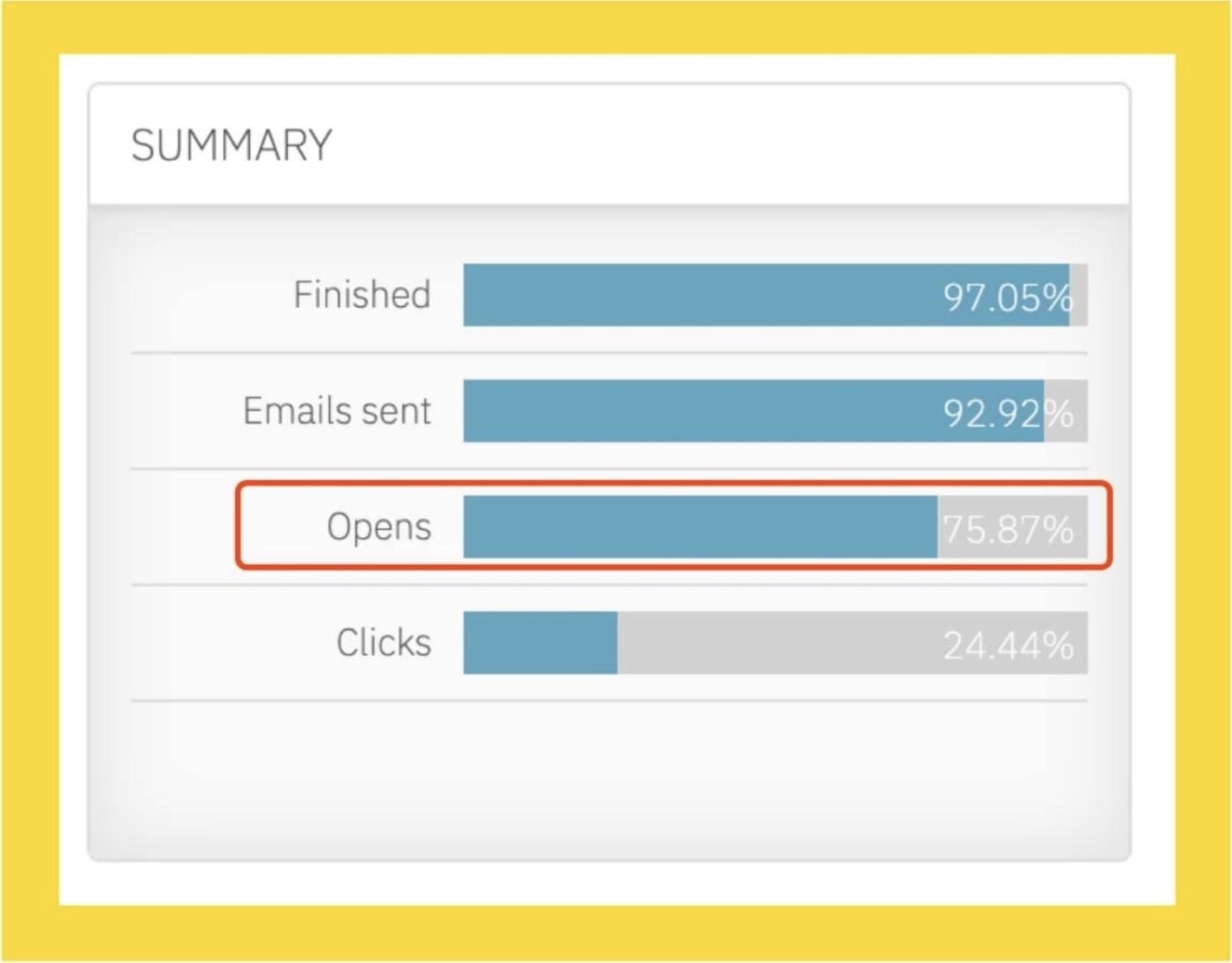
Now do you see how powerful an email list really is?
Don’t sleep on email marketing if you’re hoping to get people to read your blog. This is one of the best methods out there!
Traffic Tip #5: Don’t Fall Into the Social Media Trap

Social media is an important part of blogging so long as it’s used correctly. Otherwise, it turns into a time-sucking cycle that won’t do much to drive traffic to your blog!
When we first started Adventure In You, I was all over social media. I’m talking Facebook, Instagram, Pinterest, even Twitter!
I was posting all the time, constantly picking out pictures and thinking up captions, and we actually ended up with a decent following…
BUT this did almost nothing to drive traffic to our blog.
This is the social media trap!
The social media trap is a common blogging mistake where you end up putting tons of time into different social media platforms and get caught up in vanity metrics like likes and followers. This does nothing to help your blog’s traffic!
If you just sign up for a bunch of social accounts and randomly start posting with no goal in mind, you’ll quickly realize that social media isn’t going to help you get traffic to your blog.
However, if you create a smart marketing plan centered around promoting your blog content on social platforms where your audience actually hangs out, you’ll find that it can be really beneficial in terms of getting people to visit your blog, read your articles, and share your posts.
This goes back to the first traffic tip: knowing and understanding your audience.
If you center your social media strategy around what platforms your readers use most, their online habits, and what appeals to them while scrolling, you’ll be able to use social media to redirect them to your blog.
We actually recommend focusing on one or two platforms instead of spreading yourself thin by posting on every platform under the sun. Focus on where your audience hangs out and put your efforts into those platforms!
Remember, using social media should always go back to driving traffic to your blog. If you’re actively using Instagram, Facebook, and any other platform but it’s not getting your content in front of more eyes, it may be time to reconsider your strategy.
What’s Next for My Blog?
So you’re working, working, working and wondering what to do next…
Well, blogging is a marathon, not a sprint. It takes some time, dedication, and hard work before you’ll start to actually see results.
But there’s one key thing you should know about blogging: it works on the basis of the compound effect.
What does that mean?

Everything you’re doing now, all the small tasks and optimization and link building and engaging with your audience, will add up to something so much greater down the road. It just takes some time to compound.
Because of this, it’s so important not to give up!
I can guarantee that if you make the time to work strategically and consistently on your blog using the strategies laid out here, you will start to drive traffic and readers to your blog.
That being said, these strategies aren’t a one-time cure. They’re methods that you must stick with throughout your entire blogging journey… and ultimately they’ll lead to your success, when done consistently and well.
You can’t just do keyword research one time or only get one backlink or forget about providing value to your readers in all the content you offer. You need to continuously work at them to reap the benefits.
And let me just tell you, it’s absolutely 100% worth it.
Continuous traffic results to passive income which in return, gives you more time freedom.
If you’re still wondering where to go next with your blog, we’re here to help! Blogging Fast Lane can really put you on the fast track to blogging success.
Using our FAST Framework, we teach our students exactly how to grow their blog into an Affiliate Machine to capture readers, keep them and make some money along the way.
Plus, it’s designed to work even if you don’t have a ton of time… People with a full-time job – Yes, I’m looking at you!
Not only will the course show you how to get people to read your blog, but we will lead you through all the steps of building a successful blog through our tried and true methods that we continue to use on Adventure In You.
Check out our FREE training to learn how you too can profit from your passions!
Like this Article? Pin it!



Awesome and full of tips. I have my notes, now need to put into action. Another great read. Thanks Anna
I’m happy you enjoyed this article, Holly!!